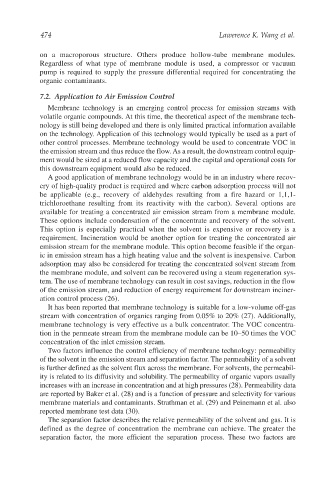Page 502 - Air Pollution Control Engineering
P. 502
12_ch_wang.qxd 05/05/2004 5:26 pm Page 474
474 Lawerence K. Wang et al.
on a macroporous structure. Others produce hollow-tube membrane modules.
Regardless of what type of membrane module is used, a compressor or vacuum
pump is required to supply the pressure differential required for concentrating the
organic contaminants.
7.2. Application to Air Emission Control
Membrane technology is an emerging control process for emission streams with
volatile organic compounds. At this time, the theoretical aspect of the membrane tech-
nology is still being developed and there is only limited practical information available
on the technology. Application of this technology would typically be used as a part of
other control processes. Membrane technology would be used to concentrate VOC in
the emission stream and thus reduce the flow. As a result, the downstream control equip-
ment would be sized at a reduced flow capacity and the capital and operational costs for
this downstream equipment would also be reduced.
A good application of membrane technology would be in an industry where recov-
ery of high-quality product is required and where carbon adsorption process will not
be applicable (e.g., recovery of aldehydes resulting from a fire hazard or 1,1,1-
trichloroethane resulting from its reactivity with the carbon). Several options are
available for treating a concentrated air emission stream from a membrane module.
These options include condensation of the concentrate and recovery of the solvent.
This option is especially practical when the solvent is expensive or recovery is a
requirement. Incineration would be another option for treating the concentrated air
emission stream for the membrane module. This option become feasible if the organ-
ic in emission stream has a high heating value and the solvent is inexpensive. Carbon
adsorption may also be considered for treating the concentrated solvent stream from
the membrane module, and solvent can be recovered using a steam regeneration sys-
tem. The use of membrane technology can result in cost savings, reduction in the flow
of the emission stream, and reduction of energy requirement for downstream inciner-
ation control process (26).
It has been reported that membrane technology is suitable for a low-volume off-gas
stream with concentration of organics ranging from 0.05% to 20% (27). Additionally,
membrane technology is very effective as a bulk concentrator. The VOC concentra-
tion in the permeate stream from the membrane module can be 10–50 times the VOC
concentration of the inlet emission stream.
Two factors influence the control efficiency of membrane technology: permeability
of the solvent in the emission stream and separation factor. The permeability of a solvent
is further defined as the solvent flux across the membrane. For solvents, the permeabil-
ity is related to its diffusivity and solubility. The permeability of organic vapors usually
increases with an increase in concentration and at high pressures (28). Permeability data
are reported by Baker et al. (28) and is a function of pressure and selectivity for various
membrane materials and contaminants. Strathman et al. (29) and Peinemann et al. also
reported membrane test data (30).
The separation factor describes the relative permeability of the solvent and gas. It is
defined as the degree of concentration the membrane can achieve. The greater the
separation factor, the more efficient the separation process. These two factors are

